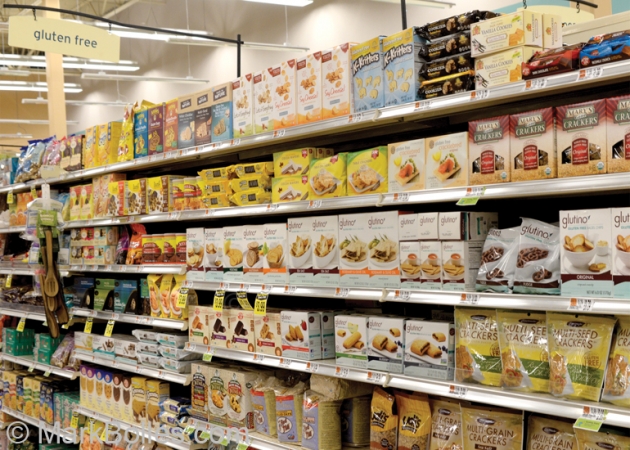Local’s React To A Growing Phenomenon.
SARATOGA SPRINGS – When I was first assigned this topic, I knew of the expression “gluten free,” but knew little else about the subject. As I researched, each finding led to more questions.
For many people, there are many misconceptions and questions: for instance, is it a healthy lifestyle choice that they could consider? For others, an apparently growing segment of our population, there is no choice at all.
For some people, a gluten-free diet may not be a matter of life or death—but if you ask them, they will tell you that it certainly feels that way.
I consulted with Dr. Marcia McCormack, a local professor of nutritional science at SUNY Adirondack, as well as other of our neighbors to get a handle on local responses to a growing phenomenon, of varying levels, to what might best be called dietary distress.
Some local people have responded by growing businesses that serve that portion of our population for whom basic everyday foods that we take for granted are so toxic that, once ingested, literally go to war with their bodies.
But who is affected, how are they affected and how many are affected? All worthy questions, for which science and research only has partial answers at this point. Yet there is no doubt that the affected segment is growing.
If you want evidence, walk into any major supermarket. For instance, we visited our local Hannaford (#95 on Weibel Avenue) where Manager Steve Robyck and Assistant Manager Paul Gizzi showed us that currently their store has 28 feet of shelf space for gluten-free products, plus “two doors of frozen foods” and some specialty endcaps. Bottom line: you don’t dedicate this kind of space without a justification. Nor, because of the cost involved, does a major manufacturer, for instance Barilla pasta, come out with a whole line of gluten-free products unless they are confident that there are enough people to buy them.
But we are getting ahead of things. For those who know little about the subject, a few basic questions need to be answered:
1) What is gluten? According to Dr. McCormack, gluten is a protein found in common foods that contain wheat, rye and barley among other basic ingredients. It is the substance that makes pizza dough stretchy and bread spongy. Gluten is also used as a thickener in sauces and soups, which can make it sneakily pervasive in modern processed foods.
2) What does gluten do? What is the danger of consuming gluten-rich products? For most people, there is no danger, although the research is inconclusive as to whether avoiding gluten is a good dietary choice for those who don’t need to avoid it. Currently, the science has identified three levels of conditions where gluten should be avoided: gluten sensitivity, gluten intolerance and celiac disease – the latter being the most severe condition. People with full-blown celiac are subject to organ damage if they consume foods with gluten, whereas with the other two conditions will experience results that range from digestive distress to acute pain. In all three cases, the person’s digestive system rejects the given food and essential nutrients that could be derived from it (some examples are fiber and vitamin D) are not absorbed.
3) What happens when a person with celiac eats food with gluten? Simply put, nothing good.
A human’s small intestine is lined with tentacle-like receptors, called villi, which in a normal person absorbs all the essential nutrients out of a given food substance, while the waste product is vacated.
A person with celiac is likely to experience major damage to the villi and other areas of the small intestine if gluten is consumed in any form. Dr. McCormack goes further, “Damage to the small intestine causes malabsorption of nutrients, weight loss, reflux, gas, bloating, diarrhea, constipation and cramping,” These symptoms may appear in a lesser degree in those with gluten intolerance or sensitivity, but they are by no means ‘getting off easy.’
But, unfortunately, there’s more.
“Aside from gastrointestinal symptoms,” Dr. McCormack notes, “some individuals experience anemia, fatigue, lack of growth in children, infertility, osteoporosis, dermatitis and neurological complications.”
4) What is the cure? Sadly, medical science has not found one. “The only treatment is lifelong adherence to a gluten-free diet.” Dr. McCormack said.
5) How large is the universe of affected people? It depends on whom you ask; although there is no doubt that this universe is growing.
In 2012, TIME Magazine listed gluten-free as the number two food trend of the year. A market research company called Packaged Facts reported that the gluten-free market was $4.2 billion last year, and predicted that it will grow to $6.6 billion in 2017.
Dr. McCormack says that her sources estimated that about the middle of the last century 1 in 5000 people had celiac; today it is closer to 1 in 100, with similar growth rates for both gluten intolerance and sensitivity. Why the growth? According to Dr. McCormack, it falls into two broad categories: better diagnosis (for instance, what once may have been diagnosed as other things such as irritable bowel syndrome is now diagnosed properly) and genetics. While the research is by no means conclusive, apparently the genetic disposition towards celiac is a ‘super gene,’ highly likely to be passed on by either partner to his or her offspring. This goes some of the way to explaining the growing number of gluten-free products on our supermarket shelves, but it does not explain it fully. A one-percent market, if true, is not enough to justify this phenomenon.
But that same one percent is more than enough to justify a thriving market for local small businesses.
One such example is Saratoga Gluten Free Goods, a certified gluten-free bakery founded in 2008 by Jeanne Daley, MaryAnna O’Donnell and Robert Averill. The demands for their products are exploding to the extent that they are beyond capacity at their current location and are looking for bigger space.
To an extent, this was a business born of necessity as all three owners have some degree of related affliction. Robert has epilepsy, an outgrowth of MaryAnna’s celiac, for which she was diagnosed in 1998, after a decade of being tested for everything under the sun. Before embracing a gluten-free diet, she would “experience many periods of extreme fatigue; then I would be sick for weeks, a combination of joint and gastrointestinal pain.”
Jeanne, who was diagnosed with the “milder” gluten intolerance in 2009, described one incident in which she thought she was eating a gluten-free preparation at a local restaurant, but apparently the meal was cross contaminated with gluten-rich products in the same kitchen. The result was instantaneous and heart wrenching. “The pain was indescribable. I was in the bathroom five to seven times doing every thing I could to get rid of it, but nothing would give relief. Later, I had a rash all over my body for four days.” Jeanne said.
Their products are flying off the shelves at retail outlets all over our market, including 4 Seasons, Healthy Living Market and Café, 4 Earth’s Sake and Russell’s Deli. Their baked goods and breads are offered as options at many area restaurants, including Circus Café, Harvest and Hearth, Esperanto, The Local and Fifty South.
Kim Klopstock, the progressive owner of Fifty South represents another local market reaction when she made the decision about a year ago to go virtually all-gluten free. “It was in response to our customer’s wishes, but generally an exponential outgrowth of the momentum we established.” She said. “We developed a reputation for clean, fresh, farm-to-table New American cuisine.”
That, and a previous background in kosher catering gave her the momentum to become certified. “It was a one-day class, but it taught me the importance of scrupulously avoiding any co-mingling of products.” She keeps separate refrigerators for the few gluten-laden products that remain.
This extends to her bar, where gluten-free beer and even vodka are available. She reaches out to breweries and distilleries as close as Valatie or as far as Colorado to get these specialty products.
“Co-mingling and cross contamination is everything,” Kim said. “Take ivory soap. They marketed themselves as 99 and 44/100 percent pure. In the gluten world, that is not pure. Only pure is pure.”
As such, rather than bear the cost of separate fryers, oils, pots and pans—indeed, a whole second kitchen, she took the initiative to develop a whole gluten-free menu, even though she estimates that only about 20 percent of her customer base actually requires gluten-free diet. “The rest of the family has shown that they will make the sacrifice for everyone’s well-being.” And to be sure, Kim’s culinary expertise is such that any ‘flavor gap’ (a frequent complaint about gluten-free products) is more than made up. One bite of her gluten-free potato chips will make you a believer.
Regardless of taste, entire families across our market are making the same decision. “I’m too busy to start using separate pots and making separate dinners even if it were feasible to keep everything straight, which it isn’t.” Jeanne Daley said. In this case, her husband Jim (an advertising rep at Saratoga TODAY) eats gluten-free for the sake of his wife and son. He claims that taste is not an issue for him, which is also a tribute to his wife’s expertise in developing recipes for baked goods.
Entire families going gluten-free goes a way towards explaining those 28 feet of shelf space of products at our local Hannaford, yet still cannot explain it all. Dr. McCormack suggests a further factor, and a cautionary one.
“These products are being marketed to the general public, under the guise of a ‘healthier lifestyle/weight loss’ and food companies are attempting to capitalize upon this like the probiotics trend as a key for better digestive health,” she said. “This can be very dangerous, for gluten goods contribute many nutrients, minerals, fiber and B vitamins among other things to people’s diet. Anyone who goes gluten-free needs to be aware of this. Further, processed or manufactured gluten-free products may be higher in fat or sugar content in order to make them palatable.”
While recognizing the critical need for those people who must be strictly gluten-free, Dr. McCormack concludes “there’s no magic in gluten-free for people who need to lose weight.”
Yet, as another nutritionist said to me a while back, it’s hard to go up against celebrity endorsers of the gluten-free lifestyle such as Al Roker or Gwyneth Paltrow. There seems to be little doubt that the large food companies, who must manufacture gluten-free products in an entirely separate facility, are banking on star-power, at least in part, to boost the amount of products flowing off the shelves.
In conclusion, I can say that much has been learned, but there is much more to be researched. I’m in no way qualified to advise anyone on his or her individual situations, except to say that if you feel distressed please get yourself diagnosed. Until then,
Gluten-free.
For you? Maybe.
For me? No, and I say so gratefully.




























 How to resolve AdBlock issue?
How to resolve AdBlock issue? 









